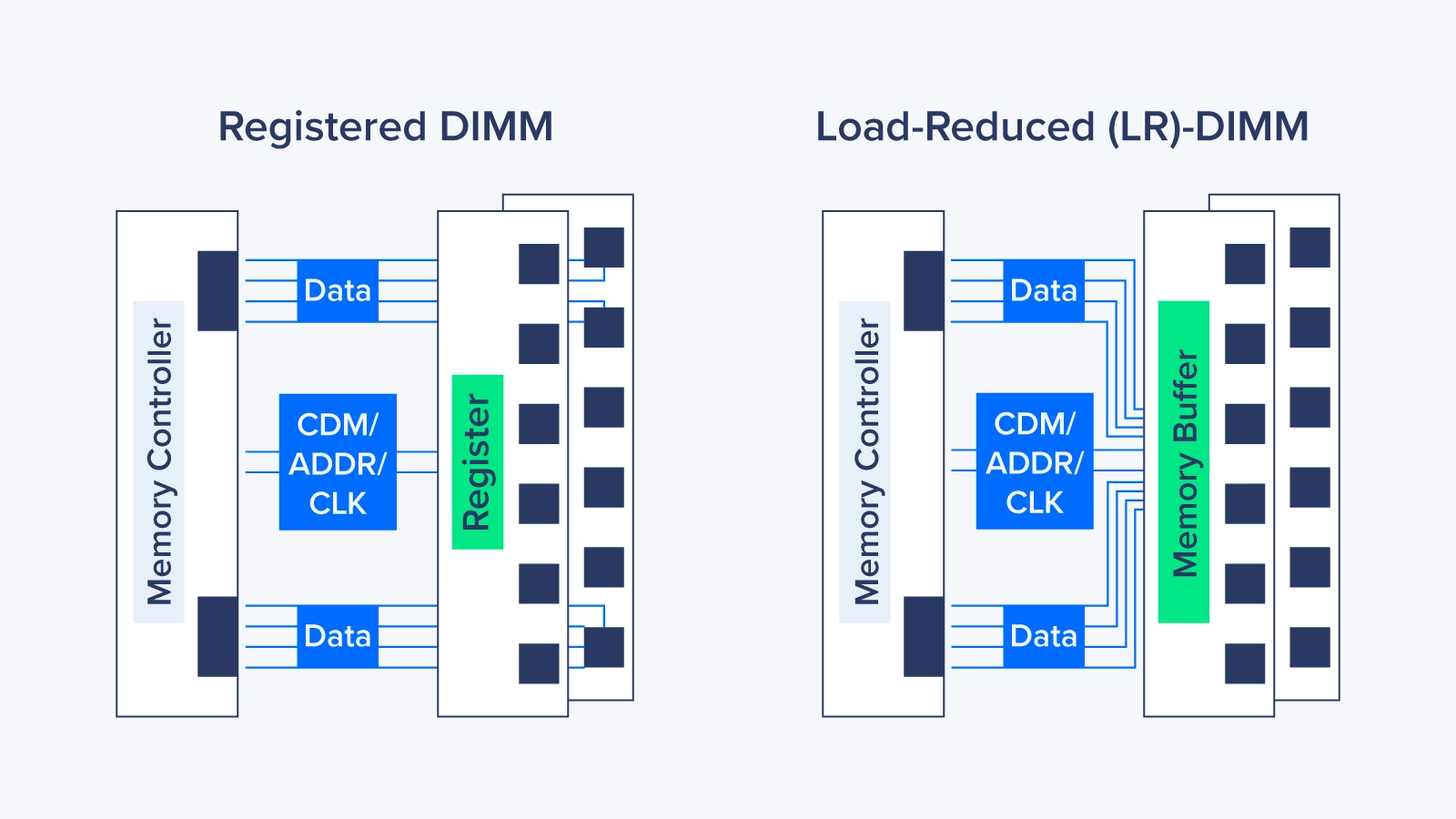
Introduction
When it comes to computer memory, having a clear understanding of different memory modules is essential. DIMMs (Dual In-line Memory Modules) are one of the most commonly used memory technologies in modern computing. They come in various types, each with its specific characteristics, suited for different applications and performance needs.
In this comprehensive guide, we'll delve into the key differences between RDIMM (Registered DIMM), and LRDIMM (Load-Reduced DIMM).
What is DIMM? Difference between DIMM and RAM?
Dual In-line Memory is a memory module interface more commonly known as name of the memory chips on the module called RAM. It is designed to provide a fast and efficient way to store and access data for the processor rather than accessing the data off of the SSD or hard drive. To understand DIMM or as we know it as RAM sticks, we need to understand what RAM is too.
For CPUs, DRAM, or dynamic random-access memory are the chips that are placed on the DIMM stick. Since each DRAM chip has a capacity of memory, it is precisely the reason capacity is referred to as “X GBs of RAM.” RAM serve as a pool of volatile memory for the CPU to access frequently during operation of a task. Running workloads and applications will load data and instructions from the storage drives to the DIMMs. The more RAM capacity a computer has, the more data and applications it can hold in its memory simultaneously for better multitasking capabilities and smoother overall performance. Insufficient RAM can cause bottlenecked performance issues, such as slow response times, lagging, and freezing, especially when running memory-intensive applications or handling large datasets.
The classic colloquial RAM sticks found in consumer devices are formally known as Unbuffered DIMMs, or UDIMMs. These modules are designed to be easy to use, cost-effective, and readily available for various applications like content consumption, productivity, and other general computing tasks. In this blog, we will focus on more specialize dual in-line memory modules found in the enterprise setting RDIMM and LRDIMM.
Differences between RDIMM and LRDIMM
| DIMM Type | Key Features | Use Cases |
|---|---|---|
| UDIMM |
|
|
| RDIMM |
|
|
| LRDIMM |
|
|
RDIMM - Registered DIMM
Registered DIMMs, or RDIMMs, are memory modules that offer increased stability and performance compared to UDIMMs. They incorporate a register or buffer to improve signal integrity and reduce electrical loading on the memory controller.
Features of RDIMMs
- RDIMMs use an additional register between the memory module and the memory controller, reducing the electrical load on the memory bus.
- The presence of the register allows RDIMMs to support higher memory capacities than UDIMMs.
- They are available in both ECC and non-ECC variants, enhancing data integrity and reliability for critical applications.
- RDIMMs typically have slightly higher latency than UDIMMs due to the additional register.
Use Cases of RDIMMs
- Servers and workstations handling intensive applications and large datasets.
- Virtualization environments that demand higher memory capacity and reliability.
- High-performance computing (HPC) clusters and database servers.
LRDIMM - Load-Reduced DIMM
Load-Reduced DIMMs, known as LRDIMMs, take memory performance to the next level by further reducing electrical loading and improving signal integrity. These modules offer the highest memory capacity and are designed for the most demanding computing environments.
Features of LRDIMMs
- LRDIMMs use an advanced buffer that not only reduces electrical load but also allows for a more efficient distribution of electrical signals.
- They can achieve the highest memory capacity among all DIMM types, making them ideal for memory-intensive tasks.
- LRDIMMs support both ECC and non-ECC configurations, providing data integrity for critical applications.
- The advanced buffering technology helps reduce power consumption compared to other high-capacity DIMMs.
Use Cases of LRDIMMs
- Enterprise-grade servers and data centers requiring immense memory capacity for virtualization and big data processing.
- Memory-intensive applications like in-memory databases and real-time analytics.
- Cloud computing platforms and virtualized environments.
Building your own system alone can be a daunting task. Exxact's experienced engineers can point you in the right direction in deciding both key components and minor technologies your workload can take advantage of! Talk to us today to grow your computing infrastructure.

In LRDIMM, data must flow through the memory buffer first.
FAQs
- What are the main differences between UDIMMs, RDIMMs, and LRDIMMs?
- UDIMMs are unbuffered and suitable for general computing. RDIMMs feature a register for improved stability and are ideal for servers and workstations. LRDIMMs use advanced buffering technology for the highest memory capacity and are designed for memory-intensive tasks.
- Which type of DIMM is more reliable, ECC or non-ECC?
- ECC (Error-Correcting Code) DIMMs provide higher reliability by detecting and correcting memory errors, making them suitable for critical applications. Non-ECC DIMMs are more affordable but lack error correction capabilities. It is worth noting all DDR5 DIMMs have an on-die basic ECC which is a plus. However, true ECC DIMMs uses sideband ECC which is the standard error correction we are used to, thus DDR5 ECC memory is still highly relevant.
- Can I mix different types of DIMMs in the same system?
- It not recommended to mix different DIMM types as it may lead to compatibility issues and reduced performance. Use identical DIMMs for optimal performance and stability.
- Are LRDIMMs backward compatible with older systems?
- LRDIMMs may not be backward compatible with all systems, as they require specific memory controllers that support load-reduced technology. Always check your system's specifications before upgrading to LRDIMMs.
- Can I use LRDIMMs for gaming purposes?
- LRDIMMs are not optimized for gaming and are better suited for enterprise-grade applications. For gaming, UDIMMs or RDIMMs (though impractical) are more appropriate choices.
- Are there any performance differences between UDIMMs, RDIMMs, and LRDIMMs with the same specifications?
- In general, LRDIMMs may exhibit slightly higher latency due to the added buffering technology. However, the actual performance differences can vary depending on the specific use case and workload.
Conclusion
In conclusion, understanding the differences between UDIMMs, RDIMMs, and LRDIMMs is crucial when it comes to selecting the right memory modules for your computer system. UDIMMs offer a cost-effective solution for everyday computing, while RDIMMs provide increased stability and memory capacity for servers and workstations. LRDIMMs, on the other hand, are the top choice for high-performance computing and memory-intensive tasks in enterprise environments.
When choosing the right DIMM type, consider your specific requirements, budget, and system compatibility. Whether you're a workload is casual or professional, selecting the appropriate DIMM will optimize your system's performance and ensure smooth multitasking and data processing.
Know exactly what you want for your workload? Talk to our team to get your system built, and shipped turnkey, quicker than you can say deep learning and AI.

Differences between Dual In-Line Memory Modules: RDIMM vs. LRDIMM
Introduction
When it comes to computer memory, having a clear understanding of different memory modules is essential. DIMMs (Dual In-line Memory Modules) are one of the most commonly used memory technologies in modern computing. They come in various types, each with its specific characteristics, suited for different applications and performance needs.
In this comprehensive guide, we'll delve into the key differences between RDIMM (Registered DIMM), and LRDIMM (Load-Reduced DIMM).
What is DIMM? Difference between DIMM and RAM?
Dual In-line Memory is a memory module interface more commonly known as name of the memory chips on the module called RAM. It is designed to provide a fast and efficient way to store and access data for the processor rather than accessing the data off of the SSD or hard drive. To understand DIMM or as we know it as RAM sticks, we need to understand what RAM is too.
For CPUs, DRAM, or dynamic random-access memory are the chips that are placed on the DIMM stick. Since each DRAM chip has a capacity of memory, it is precisely the reason capacity is referred to as “X GBs of RAM.” RAM serve as a pool of volatile memory for the CPU to access frequently during operation of a task. Running workloads and applications will load data and instructions from the storage drives to the DIMMs. The more RAM capacity a computer has, the more data and applications it can hold in its memory simultaneously for better multitasking capabilities and smoother overall performance. Insufficient RAM can cause bottlenecked performance issues, such as slow response times, lagging, and freezing, especially when running memory-intensive applications or handling large datasets.
The classic colloquial RAM sticks found in consumer devices are formally known as Unbuffered DIMMs, or UDIMMs. These modules are designed to be easy to use, cost-effective, and readily available for various applications like content consumption, productivity, and other general computing tasks. In this blog, we will focus on more specialize dual in-line memory modules found in the enterprise setting RDIMM and LRDIMM.
Differences between RDIMM and LRDIMM
| DIMM Type | Key Features | Use Cases |
|---|---|---|
| UDIMM |
|
|
| RDIMM |
|
|
| LRDIMM |
|
|
RDIMM - Registered DIMM
Registered DIMMs, or RDIMMs, are memory modules that offer increased stability and performance compared to UDIMMs. They incorporate a register or buffer to improve signal integrity and reduce electrical loading on the memory controller.
Features of RDIMMs
- RDIMMs use an additional register between the memory module and the memory controller, reducing the electrical load on the memory bus.
- The presence of the register allows RDIMMs to support higher memory capacities than UDIMMs.
- They are available in both ECC and non-ECC variants, enhancing data integrity and reliability for critical applications.
- RDIMMs typically have slightly higher latency than UDIMMs due to the additional register.
Use Cases of RDIMMs
- Servers and workstations handling intensive applications and large datasets.
- Virtualization environments that demand higher memory capacity and reliability.
- High-performance computing (HPC) clusters and database servers.
LRDIMM - Load-Reduced DIMM
Load-Reduced DIMMs, known as LRDIMMs, take memory performance to the next level by further reducing electrical loading and improving signal integrity. These modules offer the highest memory capacity and are designed for the most demanding computing environments.
Features of LRDIMMs
- LRDIMMs use an advanced buffer that not only reduces electrical load but also allows for a more efficient distribution of electrical signals.
- They can achieve the highest memory capacity among all DIMM types, making them ideal for memory-intensive tasks.
- LRDIMMs support both ECC and non-ECC configurations, providing data integrity for critical applications.
- The advanced buffering technology helps reduce power consumption compared to other high-capacity DIMMs.
Use Cases of LRDIMMs
- Enterprise-grade servers and data centers requiring immense memory capacity for virtualization and big data processing.
- Memory-intensive applications like in-memory databases and real-time analytics.
- Cloud computing platforms and virtualized environments.
Building your own system alone can be a daunting task. Exxact's experienced engineers can point you in the right direction in deciding both key components and minor technologies your workload can take advantage of! Talk to us today to grow your computing infrastructure.

In LRDIMM, data must flow through the memory buffer first.
FAQs
- What are the main differences between UDIMMs, RDIMMs, and LRDIMMs?
- UDIMMs are unbuffered and suitable for general computing. RDIMMs feature a register for improved stability and are ideal for servers and workstations. LRDIMMs use advanced buffering technology for the highest memory capacity and are designed for memory-intensive tasks.
- Which type of DIMM is more reliable, ECC or non-ECC?
- ECC (Error-Correcting Code) DIMMs provide higher reliability by detecting and correcting memory errors, making them suitable for critical applications. Non-ECC DIMMs are more affordable but lack error correction capabilities. It is worth noting all DDR5 DIMMs have an on-die basic ECC which is a plus. However, true ECC DIMMs uses sideband ECC which is the standard error correction we are used to, thus DDR5 ECC memory is still highly relevant.
- Can I mix different types of DIMMs in the same system?
- It not recommended to mix different DIMM types as it may lead to compatibility issues and reduced performance. Use identical DIMMs for optimal performance and stability.
- Are LRDIMMs backward compatible with older systems?
- LRDIMMs may not be backward compatible with all systems, as they require specific memory controllers that support load-reduced technology. Always check your system's specifications before upgrading to LRDIMMs.
- Can I use LRDIMMs for gaming purposes?
- LRDIMMs are not optimized for gaming and are better suited for enterprise-grade applications. For gaming, UDIMMs or RDIMMs (though impractical) are more appropriate choices.
- Are there any performance differences between UDIMMs, RDIMMs, and LRDIMMs with the same specifications?
- In general, LRDIMMs may exhibit slightly higher latency due to the added buffering technology. However, the actual performance differences can vary depending on the specific use case and workload.
Conclusion
In conclusion, understanding the differences between UDIMMs, RDIMMs, and LRDIMMs is crucial when it comes to selecting the right memory modules for your computer system. UDIMMs offer a cost-effective solution for everyday computing, while RDIMMs provide increased stability and memory capacity for servers and workstations. LRDIMMs, on the other hand, are the top choice for high-performance computing and memory-intensive tasks in enterprise environments.
When choosing the right DIMM type, consider your specific requirements, budget, and system compatibility. Whether you're a workload is casual or professional, selecting the appropriate DIMM will optimize your system's performance and ensure smooth multitasking and data processing.
Know exactly what you want for your workload? Talk to our team to get your system built, and shipped turnkey, quicker than you can say deep learning and AI.




